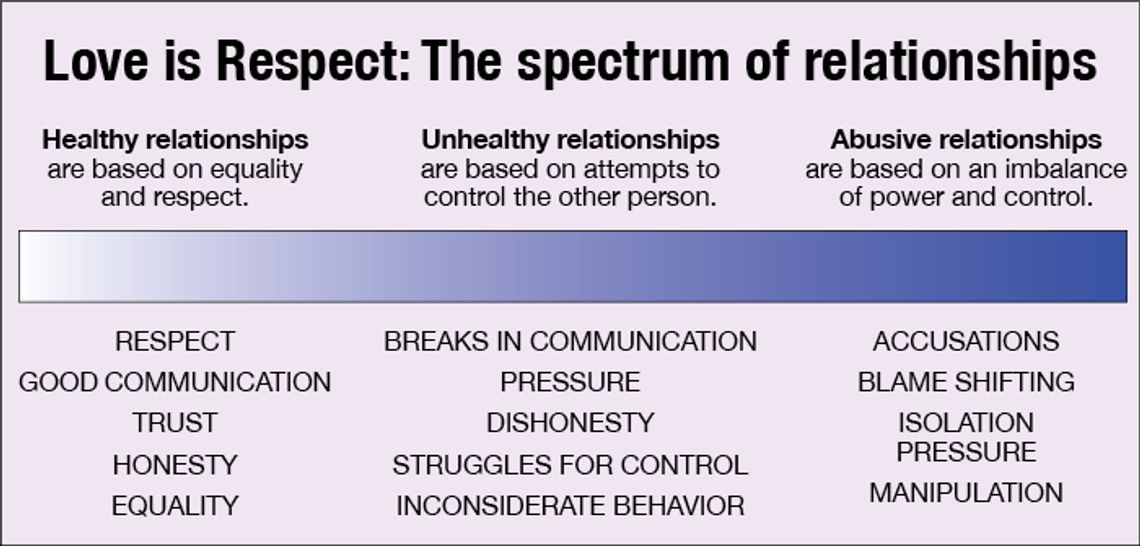By Kiara Nicholson, HCWC Prevention Educator
and Brandon Pendleton, HCWC Primary Prevention Coordinator
[dropcap]N[/dropcap]obody has relationships “figured out,” and no relationship is perfect. It might seem like that couple a few doors down from you is flawless, or your friend’s grandparents who have been married for decades are straight out of a fairytale, but no doubt they too have disagreements and bad days along with all of their good. At HCWC, we know that even though every partnership takes work, sometimes difficult work, there is no reason for violence or control to be a part of it.
If you have young people in your life, it’s important to have these hard relationship conversations and to have them more than just once. Normalize it; make it a common thing for people in your household to talk about their relationships and friendships (it might be awkward at first, but gets easier the more you do it).
A crucial factor in talking to young people about healthy relationships is not letting shame be a part of these conversations. If a young person hears that they are not allowed to have a boyfriend/girlfriend and will be in trouble if they do, or that even thinking about sex is a bad thing, it only serves to shut the conversation down. You and your teen may disagree on a lot of what you are talking about, but the most important thing is to keep the communication open. You want to be a resource that they recognize and call on when they eventually need some advice, and you can’t be that if they are afraid that you will ridicule or punish them.
It’s essential for young people to see examples of the adults in their lives resolving conflict in a healthy way, appropriate (consensual) displays of affection, and consistently showing respect to one another.
Recognizing that not only can these conversations be tricky and difficult, it can be just as challenging to know where to start or how to continue having them. One of the resources our educators share with youth is Love is Respect. Love is Respect likes to view relationships on a spectrum with healthy behaviors on one end, abusive behaviors on the either, and unhealthy behaviors somewhere in between. Depending on how often and in what context a behavior occurs, it can be placed anywhere on the spectrum at any point in time. While physical violence is never ok and is always abusive, and having direct and peaceful communication where each point of view is equally valued is always healthy, many other behaviors can end up in a gray area.
Another way to view this spectrum is to start with something that many people already know and recognize: traffic lights. Green means go, yellow mean slow down, and red means stop. Relationship behaviors can be viewed the same way. While the ultimate goal is for there to be as many green light behaviors as possible in our relationships, we all come across yellow light and red light behaviors either in our own relationship or a loved one’s relationship that signal the need for a change. It is important that we continue to have conversations about not only recognizing these behaviors that signal opportunities for a healthier change (yellow) or perhaps the time for a relationship to end (red), but remembering to emphasize teens identifying the green light behaviors they would like to have for themselves and how to recognize them.
Perhaps the most important step is to model those green light behaviors in your own life. It’s essential for young people to see examples of the adults in their lives resolving conflict in a healthy way, appropriate (consensual) displays of affection, and consistently showing respect to one another. This does so much more than talking about healthy relationships; you are actually giving them skills that they can use in their relationships and friendships now. As much as we might wish that the opposite was true, children pay attention to our actions far more than our words. It’s on all of us to talk the talk and walk the walk.
To learn more ways to get involved with HCWC visit our website, www.hcwc.org for opportunities to volunteer, donate or get information on services. You can visit our educational website www.StopTheHurt.org for more educational tools on abuse issues and resources. We also invite the public to attend our upcoming Annual Meeting on Tuesday, November 7th at 6pm at San Marcos Recreation Hall, 170 Charles Austin Drive. Our program will consist of agency highlights, award ceremony, nomination of board members and guest speaker, Wende Hilsenrod speaking on “The Commercial Exploitation of Children in America”.
This is the final article of a five-week series focusing on raising awareness about domestic violence. October was Domestic Violence Awareness month and we hope to educate our community on this very serious issue. 1 in 3 women will experience domestic violence in their lifetime. Locally, the Hays-Caldwell Women’s Center has been serving victims of domestic and dating violence, sexual assault and child abuse since 1978. Last year, HCWC served 1,872 victims of abuse (face-to-face) from Hays and Caldwell Counties. 1,050 of those were victims of domestic violence.










